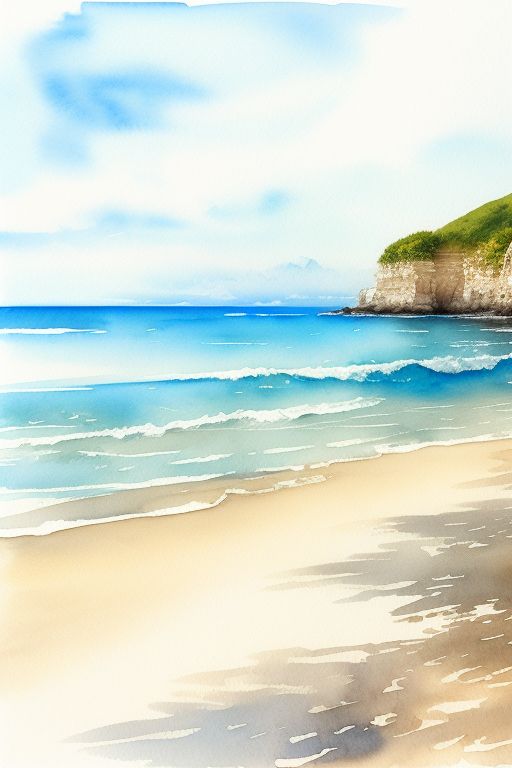Why We Return to the Edge of the Sea
There's something elemental about standing where land meets water, where certainty gives way to the constant motion of waves—something that calls to us across time and distance.


I still remember my first conscious encounter with the ocean. I was seven years old, holding my father's hand as we crested a grassy dune on a windy afternoon in late September. The Atlantic appeared suddenly—vast, gray-blue, and roaring with white-capped waves that seemed both invitation and warning. I stopped dead in my tracks, overwhelmed by the immensity of what lay before me.
"It keeps going," I whispered, "all the way until you can't see anymore."
My father squeezed my hand. "That's right. And beyond that too."
That moment—that first breathless recognition of something so much larger than myself—has been replicated countless times across human history. From the earliest coastal dwellers to modern beach vacationers, we have always been drawn to that liminal space where land surrenders to sea, where the solid gives way to the fluid, where certainty meets mystery.
The beach calls to something primal in us.
Scientists suggest our fascination might have evolutionary roots. The "biophilia hypothesis" proposes that humans have an innate desire to connect with nature and other forms of life. Coastal environments, with their abundance of resources and escape routes (both onto land and into water), may have been ideal habitats for our ancestors. Perhaps our bodies remember this ancient preference, encoded in our DNA as a persistent longing for the shore.
But beaches offer more than evolutionary advantage. They provide psychological restoration that's increasingly precious in our hyperconnected, overstimulated world. The combination of soft, light-reflecting sand, the rhythmic percussion of waves, and the expansive horizon creates what psychologists call a "soft fascination" environment—a setting that captures attention without demanding it, allowing our depleted mental resources to recover.
I've witnessed this restoration countless times, both in myself and others. The tense shoulders that gradually lower over the course of a beach day. The furrows between eyebrows that smooth as eyes adjust to focusing on distance rather than screens. The way conversation shifts from hurried exchanges of information to thoughtful reflections and comfortable silences.
"I can physically feel my brain changing when I'm by the ocean," a friend once told me. "It's like parts that have been running too hot finally get permission to cool down."
The sensory experience of beaches is unmatched in its gentle completeness. Unlike the sharp sensory contrasts of cities or the dense, enveloping nature of forests, beaches offer a balanced palette: the soft resistance of sand underfoot, the alternating coolness and warmth as toes meet water then return to sun-baked shore, the soundtrack of waves that contains both pattern and variation, the distant horizon that pulls the eye without demanding focus.
This sensory balance might explain why beaches feature so prominently in art. From Winslow Homer's crashing Atlantic waves to David Hockney's sun-drenched California shores, from Claude Debussy's "La Mer" to Jack Johnson's laid-back surf melodies, artists across mediums have tried to capture the beach's particular magic. Even in the watercolor painting that inspired this reflection—with its gentle gradients of blue, the soft foam of breaking waves, the suggestion of distant cliffs—we see an attempt to distill the essence of what draws us to these thresholds between worlds.
Beyond their sensory appeal, beaches hold a curious duality that mirrors the human condition. They are places of both permanence and constant change. The general form remains—sand, water, horizon—while the specifics transform minute by minute. No wave is exactly like the one before it; no shoreline remains precisely as it was yesterday. The light shifts, the tides rise and fall, the sand rearranges itself in endless patterns. There is something profoundly reassuring about this balance of constancy and change, perhaps because it reflects our own desire to remain ourselves while still growing and evolving.
"The waves erase my footprints," wrote poet Pablo Neruda, "and the wind, my name." This temporary quality of our presence on the shore reminds us of our smallness without diminishing our significance—a humbling but not humiliating recognition.
The beach is also where we confront both our vulnerability and our resilience. In water, we are slightly out of our element—buoyant but not quite at home. We surrender some control, relying on currents and our own adaptability. Yet in that surrender comes a different kind of strength: the ability to float, to ride waves, to exist in harmony with forces larger than ourselves. This lesson applies well beyond the shoreline.
I think often of a particular beach on Portugal's Algarve coast. Accessible only by a steep staircase cut into golden cliffs, the cove reveals itself gradually as you descend. The beach itself is relatively small, embraced by towering rock formations carved by millennia of wind and water. What makes this place remarkable is how the late afternoon sun hits the cliffs, turning them into walls of amber light that reflect onto the water, creating a pool of liquid gold. People speak in hushed tones there, as if in a cathedral.
And perhaps beaches are our cathedrals in a way—spaces where the sublime becomes accessible, where we contemplate forces beyond our comprehension, where we feel simultaneously small and part of something magnificent. Like places of worship, beaches inspire both reverence and joy, solemnity and celebration.
They are also profoundly democratic spaces. While access has sometimes been restricted by social barriers or private ownership, the beach itself makes no distinctions. The waves break the same for everyone; the sand conforms to all footprints; the horizon extends equally for all eyes that seek it. There is a leveling quality to beach life that temporarily suspends the hierarchies we construct elsewhere. The CEO builds sandcastles alongside the school teacher; the athlete and the academic both surrender to the rhythm of the waves.
This democratizing effect extends to time as well. On the beach, we engage in activities that humans have enjoyed for thousands of years—swimming, wading, collecting shells, watching the play of light on water. A child digging in the sand today would be recognizable to people across millennia. There's comfort in this continuity, this participation in experiences that transcend our particular moment in history.
As our climate changes and sea levels rise, many beloved beaches face uncertain futures. Erosion claims shorelines; development pressures threaten access; pollution challenges the health of marine ecosystems. Our relationship with these precious spaces is becoming more complicated, tinged with awareness of their fragility. Perhaps this growing recognition of vulnerability makes them even more precious to us—more worthy of protection and mindful enjoyment.
I return to that watercolor image that prompted these reflections—the gentle wash of blue extending to a distant horizon, the suggestion of cliffs, the empty expanse of sand. What strikes me is how it captures not just the physical features of a beach but the feeling of being there: the openness, the possibility, the invitation to breathe deeply and exist fully in the present moment.
In our increasingly fragmented attention economy, beaches offer a rare gift: the permission to be wholly present, attending to simple sensations and elemental truths. The feel of sand between toes. The taste of salt on lips. The sound of waves that preceded us and will continue long after we're gone.
We return to the edge of the sea not just for recreation but for re-creation—a chance to remember who we are beneath the layers of identity we construct in our daily lives. At the shoreline, we are simply humans, poised between worlds, momentarily free from the constraints of time and social expectation, connected to something ancient and enduring.
No wonder we keep coming back.
Get in touch


